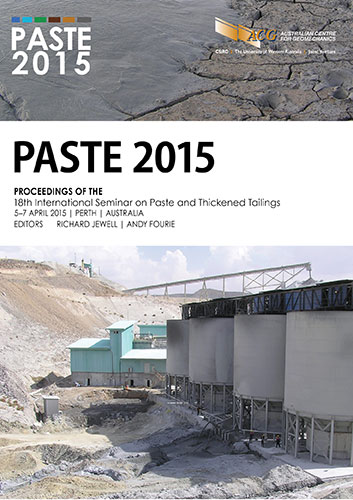Paste backfill system design and commissioning at Chambishi Copper Mine

|
Authors: Wu, AX; Miao, XX; Liu, XH; Wang, YM; Wang, CL; Zhang, JJ |
DOI https://doi.org/10.36487/ACG_rep/1504_22_Xiuxiu
Cite As:
Wu, AX, Miao, XX, Liu, XH, Wang, YM, Wang, CL & Zhang, JJ 2015, 'Paste backfill system design and commissioning at Chambishi Copper Mine', in R Jewell & AB Fourie (eds), Paste 2015: Proceedings of the 18th International Seminar on Paste and Thickened Tailings, Australian Centre for Geomechanics, Perth, pp. 301-308, https://doi.org/10.36487/ACG_rep/1504_22_Xiuxiu
Abstract:
West orebody is now the main production zone of Chambishi Copper Mine. Upward drift stoping is performed to meet the annual ore production of more than 1 Mt. Cemented classified tailings backfill was originally employed, which then proved to be both economically and operationally impractical due to high cement cost, low metal recovery, severe backfill tailings shortage, etc. As an alternative, the current paste backfill system with low cement addition was suggested after a comprehensive study and investigation. Construction work of the paste backfill system started in 2012. The system was put into production at the beginning of 2014 after commissioning. During commissioning, the backfill system reached a capacity of 60 m3/h with the paste concentration of 68 to 70%, and the friction loss of the pipeline transport was 4-6 MPa/km. To meet the backfill strength, the cement to tailings ratio for primary stopes was 1:12, and 1:30 for secondary stopes. As a result, the composite cost for backfill was only USD 15 to 20 /m3, while ore recovery increased by 35% and mining to cutting ratio dropped by 80 m3/kt. Since commissioning investigations indicate that this paste backfill system will be capable of prolonging west orebody’s service by about 10 years, and will bring about enormous economic returns. This paper presents the case study of the highly automated system and its commissioning performance, with emphasis on key processes including unclassified tailings thickening, two-stage slurry mixing, paste pumping, and underground backfill.
References:
Feng, M 2009, ‘Tailings thickening and surface disposal of paste tailings’, Modern Mining, no. 10, pp. 82-86.
Ge, F 2013, ‘Application and optimization of filling mining in Fengshan Copper Mine’, Nonferrous Metals (Mining Section), vol. 65, no. 1, pp. 20-23.
Jewell, RJ & Fourie, AB (eds) 2006, Paste and Thickened Tailings – A Guide, 2nd edn, Australian Centre for Geomechanics, Perth, Western Australia.
Liu, TY & Cai, SJ 1998, ‘Status quo of application and research of paste fill technology in China and abroad’, China Mining Magazine, vol. 7, no. 5, pp. 1-4.
Liu, XH, Wu, AX, Wang, HJ, Yan, QW & Rong Y 2009, ‘A primary discussion on the thickening law of paste-filling’, Metal Mine, no. 9, pp. 38-41.
Ma, DJ, Wang, YM, Wu, AX, Ai, ChM, Yang, XX & Zhou, FL 2014, ‘Underhand drift paste backfill mining in broken and refractory mines’, Metal Mine, no. 3, pp. 21-25.
Wang, HJ, Wu, AX, Xiao, WG, Zeng, PH, Ji, XW & Yan, QW 2009, ‘The progresses of coarse paste fill technology and its existing problem’, Metal Mine, no. 11, pp. 1-5.
Wang, PX, Yuan, JQ & Wang, WS 2002, ‘Equipment selection of pumping paste filling’, Nonferrous Mines, vol. 31, no. 1, pp. 10-12.
Yang, ZQ, Wang, YQ, Gao, Q, Chen, DX & Yao, WX 2014, ‘Technology reconstruction and application of the paste filling system to tailings in Jinchuan nickel mine’, Nonferrous Metals Science and Engineering, vol. 5, no. 2, pp. 1-9.
© Copyright 2025, Australian Centre for Geomechanics (ACG), The University of Western Australia. All rights reserved.
View copyright/legal information
Please direct any queries or error reports to repository-acg@uwa.edu.au
View copyright/legal information
Please direct any queries or error reports to repository-acg@uwa.edu.au